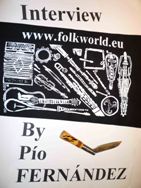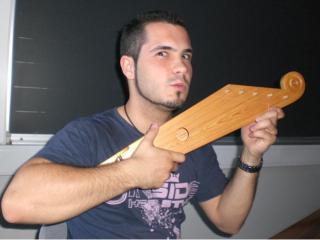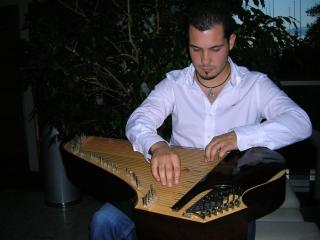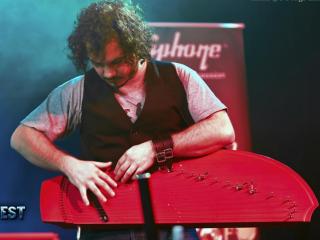
The kantele is a traditional plucked string instrument of the dulcimer and zither family native to Finland and Karelia (Finland-Russia border regions). Juan Luis Alonso, a member of the folk-rock band from Madrid ‘Street Wings’, tells us a few things about his experiences on the learning of this instrument, and the playing in his band until today in 2013.

The Kantele: A Short Introduction
The oldest forms of kantele have 5 or 6 horsehair strings and a wooden body carved from one piece; more modern instruments have metal strings and often a body made from several pieces. The traditional kantele has neither bridge nor nut, the strings run directly from the tuning pegs to a metal bar (varras) set into wooden brackets (ponsi). Though not acoustically efficient, this construction is part of the distinctive sound of the kantele.
Modern instruments with 15 or fewer strings are generally more closely modeled on traditional shapes, and form a category of instrument known as small kantele, in contrast to the modern concert kantele. Modern concert kantele can have up to 40 strings. The playing positions of concert kantele and small kantele are reversed: to the player of a small kantele the widest low pitched strings are farthest away from his body, whilst to a concert kantele this side of the instrument is nearest, and the short high pitched strings farthest away. Concert versions have a switch mechanism (similar to semitone levers on a modern folk harp) for making sharps and flats.
The kantele has a distinctive bell-like sound. The Finnish kantele generally has a diatonic tuning though small kantele with between 5 and 15 strings are often tuned to a gapped mode missing a seventh and with the lowest pitched strings tuned to a fourth below the tonic as a drone. Players hold the kantele in their laps or on a small table. There are two main techniques to play, either plucking the strings with their fingers or strumming unstopped strings (sometimes with a matchstick). The small and concert kanteles have different though related repertoires.
There have been strong developments for the kantele in Finland since the mid 20th century, starting with the efforts of modern players such as Martii Pokela in the 1950s and 1960s. Education for playing the instrument starts in schools and music institutes up to conservatories and the Sibelius Academy, the only music university in Finland. Even some artistic doctoral studies have been made at the Academy with traditional, western classical and electronic music. A Finnish luthiery, Koistinen Kantele, has developed also an electric kantele, which employs pick-ups similar to those on electric guitars.
© en.wikipedia.org/wiki/Kantele

Learning to Play the Kantele
When you look at a world map, you see Finland in the Northeast corner of Europe, while Spain is in the complete opposite side, in the SW end of the continent. Finland has Arctic climate especially during the winter time, while Spain can reach summer temperatures almost like those in the hottest North of Africa. And when thinking of culture or music traditions, the differences are many times as extreme as well. Those facts did not stop the musician from Madrid Juan Luis Alonso from becoming interested in one of Finland’s most traditional instruments, the kantele, to the point of travelling to Finland and spending there quite some time learning how to play it. Their case is similar to the one of Ana Alcaide and her experience with the nyckelharpa in Sweden.[42]
Pío FERNÁNDEZ: I realize that you play several traditional instruments, like the Galician gaita bagpipes or the Irish traverse flute. Do you have family roots in the North of Spain? Where does this interest in traditional and ‘Celtic’ music come from?
Juan Luis ALONSO: So it is, all my family comes from the north of Spain, specifically from Burgos. We have very deep “Celtic roots” and I have always loved the sound of the gaitas (bagpipes) and the dulzainas (shawms). In addition, my family loves music and they always tried to keep us in touch with the traditional music and dances from the whole of our country, not just from Castile (Spain’s centre region).
I began to play the bagpipes when I was eighteen years old in the Galician Centre in the village of Collado Villalba (in the northwest mountains of Madrid’s province), through Darío Nogueira, a great teacher, a good friend and an even better bagpiper. After that, I had different masters, and so I still have them because a musician never stops to learn.

Which traditional and folk music bands have you played with?
Well, during my first years as a piper I played in two bagpipe bands: “Lume de Biqueira” from Madrid city, and “O son do Ar” from Collado Villalba. Then I tried to start my own folk-rock band with some friends from those bagpipe bands, but it didn't work. After that I started a new project called “Zamburiel” with a couple of friends, and it worked for years. The band still exists today in 2013, but I had to leave it when I began to have less time because “Street Wings” is a demanding lover and I had to make a choie.
I have also played as a guest of Judith Mateo´s band, Ensemble Anxamas, TradOne, Hevia, Carlos Nuñez (with whom the Street Wings have a very good relationship), and some other folk artists. In my opinion, the best part of folk music is that it is very easy to make friends and to share stages and beers with them.
So, when and how did you start getting interested in the kantele?
My uncle Antonio Capellán went to Finland to teach Latin at the University of Helsinki and he spent some days with other Latin teachers from there. They introduced him to the kantele, and he fell in love with the sound of this marvellous instrument. When he came back to Spain, he showed me some recordings played by the greatest masters of the kantele...and it was magical. I had always looked for this instrument, but I didn't know it at that time hehehe...
When did you decide to go to Finland and how did you find the right places, teachers, etc....?
My uncle and my aunt paid my first kantele camp as a present after graduating from my Teachers Degree. They arranged everything for me, because they met some Sibelius Academy professors during their trip to Finland, who helped me during my first times there.
What can you tell us about the learning experience with the kantele in Finland?
The first year I went to the Kuhmo and Kaustinen folk festivals to begin my learning. The program of those festivals offered private kantele classes through Arja Kastinen, Vilma Timonen, Eva Alkula, Pauliina Sirjala and other great masters. It was very useful to get in touch with the instrument and to contact the most experienced musicians. There I met the teacher and musician I most I admire in the world, a kantele god and a good friend, Timo Väänänen.
But the band camp is just for the summer and if you want to learn the instrument, you have to live in Finland and to study in a music academy, and so I did. I went to Finland to study for two years and I also took my private classes with several teachers while I worked in three different things at the same time to pay them, because life is very expensive in Finland. That is one of the biggest problems I had there, apart of the weather, sometimes the language and the 3 months night - hehehe.

STREET WINGS: Folk Rock from Madrid
STREET WINGS is a band from Spain’s capital (Madrid), that now in 2013 after three years playing together, has probably become the city’s most successful young folk-rock group.
STREET WINGS performs a repertoire based on folk-rock songs written by themselves, plus a number of traditional standards coming from Galician, Irish, Scandinavian, country or bluegrass music.
The members of STREET WINGS are:
Juan Luis ALONSO: He is a college graduate in musical education in Madrid and Valladolid. He has also been a member of the Galician gaita bagpipes band from NW-Madrid, and the folk band Zamburiel. Juan Luis plays the Galician gaita bagpipes, tin whistles, Irish traverse flute, and the Finnish kantele. He travelled to Finland to learn how to play the instrument with accomplished teachers such as Arja Kastinen, Eva Alkula, Vilma Timonen or Timo Väänänen.
David CASTRO: Born in 1987, he is also a college graduate in musical education. David has played the electric guitar in bands such as: Ensemble Anxamás, Iván HH, Novana or Jean Bruce & The Fangs.
Jitka KUBEšOVÁ: Born in 1989 in the Czech Republic, she started learning violin playing at the age of 7. At the age of 15, she played with the bands Bryčka (country) and Alreens (Irish folk). Four years later she also played with two Italian country-rock bands. In 2010, she arrived in Spain and shortly after, Jitka joined STREET WINGS. Regardless of her young age, she has accumulated an extensive experience in music festivals across Europe.
Manuel LARCHER: He started learning classical guitar at the age of 11. Three years later, he started experimenting with the electric guitar, and when he was 18 he switched to the electric bass guitar.
Vicente HERVÁS: He took 6 years of piano lessons as a child, but at the age of 15 he started learning to play the drums with several professional musicians. He has played in Madrid’s bands: Sativa, Eclíptika, Iván HH, Presagio, Zamburiel and Ensemble Anxamás.
I play two kinds of kanteles, the small 16-strings kantele and the big 39-strings concert kantele. Both have their own techniques and their own characteristics which make them almost two different instruments.
Who do you consider the top makers for these instruments?
There are some marvellous kantele makers around the world. I think the most famous in Finland are Koistinen and Lovikka. But I have heard marvellous things about other kantele makers, such as Kirjokansi. All musicians have their own preferences and they will choose the instruments that inspire them the most.
Which Finnish artists can you recommend to somebody interested in the kantele music?
As I said, my favourite soloist is Timo Väänänen, but there are some others I like as Vilma Timonen and her Quartet, Eva Alkula, Pauliina Sirjala...and great bands like Värtinä. Now a new generation of young musicians is incoming who are “punching” hard, like Anttu Koistinen (almost an electric guitarist with the kantele), Juha Jyrkäs (amzing how this guy mixes “Metal” with folk) and Kardemimmit, a girl band with a very sweet, personal and precious music style.
Any good resources in Internet that you can recommend?
The best connection point for kantele community is www.kantele.net, everyone can find information about everything you need about the kantele world.
What kanteles do you own today and where did you get them?
I have three Lovikka kanteles and I can say he´s my favourite maker, because his kanteles have a special deep sound that I love the most. Each kantele is different, for example you can choose the wood, the colour, the number of strings... and sometimes the material of the strings. For example I have seen brass strings, steel strings and gut strings, and the sound is completely different. For the moment I prefer steel strings for my sound in “Street Wings” but I'm thinking about buying a brass stringed kantele for the next year.

What criteria do you follow today for the use of the kantele on certain songs, as the ones played by your folk-rock band Street Wings?
Well, this is a funny question because when we are working on a new song, we don't think -hey! Here is a new song for the kantele! Take it and play- in fact, the first time we listen to a new song from someone of the band, the kantele appears in our minds even though I'm not playing, and we say at the same time -hey! Don´t you hear a kantele there?- Maybe it is part of the magic of the instrument, or maybe it is that during the time we have been playing together in “Street Wings” we have developed a hive mind... I don´t know. But normally it is our music who asks for the kantele.
Do you have plans in the future to continue with the kantele (new travels to Finland, dedicated projects on learning, playing, teaching, etc...)?
Of course I have! Next year I have to go to work in the United States, and thanks to the help of my friends in Finland and the Kantele Association I have found some kantele players there and I wish to continue my studies and practising. And maybe one day I can go back to Finland to the band camp or to Sibelius Academy to continue my studies.
Only time knows.
Photo Credits:
Juan Luis Alonso: (1) 5-String-Kantele,
(2) 16-Steel-String-Electric-Kantele;
(3) 39-Steel-String-Concert-Kantele,
(4) Street Wings
(unknown).